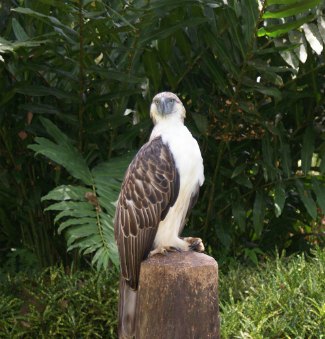Philippine Eagle - Pithecophaga jefferyi
By Harrybalais, CC-BY-SA-3.0, via Wikimedia Commons
Family: Accipitridae
Genus: Pithecophaga
Species: P. jefferyi
Philippine Eagles are some of the largest eagles in the world and also among the most endangered. With only 180-500 individuals remaining, they have a low survival rate and face threats from habitat loss. They are endemic to the islands of Luzon, Leyte, Samar, and Mindanao and live in primary forest.
Physical Description:
Philippine Eagles are dark brown from above with a buff crown and nape streaked with black. Long feathers around the neck form a loose, almost puffy crest. The underside is snowy white with rufous streaking along the thighs, and the long squared tail is brown with a white tip, dark subterminal band, and a gray undertail. Their wings are short and rounded; the lesser wing-coverts are also marked rufous and the primary feathers are barred. The flight feathers are black-tipped. The eyes and cere are gray, and the large feet are yellow with black talons.
Juveniles are similar to adults but are paler in color.
Their call is a high-pitched whistle that is rather weak compared to their size. Listen to a Philippine Eagle.
Captive birds have lived to be over 40 years old.
Size:
Length: 86-102 cm
Wingspan: 2 m
Weight: 4.7-8.0 kg
By scorpious18, CC-BY-2.0, via Wikimedia Commons
Habitat and Distribution:
They occur in primary dipterocarp forest (forests with resinous trees), forest edges, gallery forest, and logged forest, primarily along mountainsides. Nests have been found in a range of locations including old- and second-growth forest and even places with significant human disturbance. They live from 0-1,800 meters above sea level though it is less likely that they breed at higher altitudes, due to the size of the trees. Pairs control territories of up to 133 km² on average; territories are smaller, only about 68 km², in forests.
They are endemic to four islands in the Philippines: Luzon, Leyte, Samar, and Mindanao, from 18°N to 6°N. The island of Mindanao supports the majority of the population, with around 82-233 breeding pairs. There are approximately 180-500 individuals over 146,000 km². Adults are sedentary within their range.
Diet and Hunting:
They eat a range of animals. Mammalian prey includes flying lemurs, flying squirrels, macaques (hence their alternative name of Monkey-Eating Eagle), pigs, dogs, fruit bats, and even small deer. Birds such as poultry are known to be taken, along with Philippine cobras and monitor lizards.
Philippine Eagles hunt from a perch or by searching dense vegetation and knotholes for food. They are also known to hunt cooperatively in pairs, where one eagle distracts the prey and the other attacks; this strategy is similar to one utilized by Stephanoaetus coronatus (Crowned Hawk Eagle). They are capable of speeds up to 80 km per hour.
Reproduction:
Breeding displays consist of circling, dive chases, and claw-grappling. The egg-laying season begins in September-October and ends in February on Mindanao, but ends in December-January on Luzon. Pairs are monogamous, though if one partner dies the remaining eagle will find a new mate.
The nest is built out of sticks and placed in the fork of a tree 27-50 m high. Nests can be up to 1.2 m across and 2.7 m deep and are used for years in a row. 1-2 white eggs are laid, though two eggs were observed hatching only once. Prior to egg-laying, females exhibit "egg lethargy", where they act sick and refuse food for 8-10 days; it ends when the egg is laid and incubation begins. The egg is incubated for 58-68 days by both parents, with the female doing two-thirds of it. Fledging takes 4-5 months and juveniles are dependent on their parents for 17 months after that. Consequently, adults are limited to breeding once every two years.
Female Philippine Eagles are sexually mature after five years and males after seven.
By markaharper1, CC-BY-SA-2.0, via Wikimedia Commons
Conservation:
Philippine Eagles are among the most endangered raptors in the world. Two causes are low survival rates among juveniles and immatures and the eagles' inability to travel through disturbed habitats and forest fragments. Habitat loss is another major threat, since most lowland forest is open to logging and it is estimated only 9,220 km² of old-growth forest remains within the their range. Mining is also another problem. The raptors are currently listed as Critically Endangered by BirdLife International.
Conservation measures undertaken including captive breeding and reintroduction, conservation education, and legislation that prohibits the persecution of Philippine Eagles and protects their nests. Reintroduction methods have met with some success, though the first eagle released in 2004 was electrocuted after nine months and the second was killed by a hunter only four months after release.
Conservation measures proposed including conducting more research into their ecology, population, and distribution, extending protected areas, and managing their habitat.
Taxonomy:
Based on the molecular sequences of one nuclear intron and two mitochondrial genes, it was found that Pithecophaga jefferyi is closely related to Terathopius ecaudatus (Bateleur). Pithecophaga is also a sister genus to snake eagles.
Other Names:
Great Monkey-Eagle Eagle, Great Philippine Eagle, Monkey-Eating Eagle, Philippine Monkey-Eating Eagle, Abeørn (Danish), Apenarend (Dutch), Ahbikotkas (Estonian), Filippiinienkotka (Finnish), Aigle des singes (French), Affenadler (German), Aquila delle Filippine, Aquila delle scimmie (Italian), Firipinwashi (Japanese), Apeørn (Norwegian), Malpozer (Polish), Águila Comemonos, Águila Monera (Spanish), Apörn (Swedish).
Heraldry:
The Philippine Eagle was declared the National Bird of the Philippines on July 16, 1995.
Video of a Philippine Eagle:
References:
Sison, F. and A. Fraser. 2006. "Pithecophaga jefferyi" (On-line), Animal Diversity Web. Accessed February 06, 2012
http://animaldiversity.ummz.umich.edu/site/accounts/information/Pithecophaga_jefferyi.html.
http://www.arkive.org/philippine-eagle/pithecophaga-jefferyi/
http://avibase.bsc-eoc.org/species.jsp?avibaseid=B3B046ECBA553372
http://birdbase.hokkaido-ies.go.jp/rdb/rdb_en/pithjeff.pdf
BirdLife International (2012) Species factsheet: Pithecophaga jefferyi. Downloaded from http://www.birdlife.org on 06/02/2012.
Global Raptor Information Network. 2012. Species account: Philippine Eagle Pithecophaga jefferyi. Downloaded from
http://www.globalraptors.org on 6 Feb. 2012
BirdLife International 2009. Pithecophaga jefferyi. In: IUCN 2011. IUCN Red List of Threatened Species. Version 2011.2.
www.iucnredlist.org. Downloaded on 06 February 2012.
http://mindanaoexaminer.com/news.php?news_id=20110715041821
http://www.peregrinefund.org/projects/philippine-eagle
http://www.philippineeagle.org/index?pageval=thephileagle
http://www.planetofbirds.com/accipitriformes-accipitridae-philippine-eagle-pithecophaga-jefferyi
Ferguson-Lees, James, and Christie, David A. Raptors of the World. Houghton Mifflin Company, 2001.


